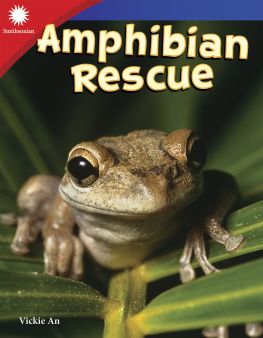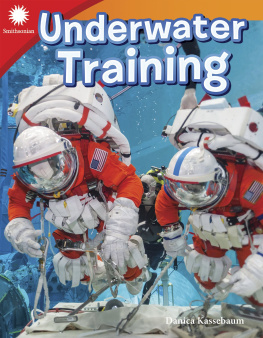
Contributing Author
Allison Duarte, M.A.
Consultants
Tamieka Grizzle, Ed.D.
K5 STEM Lab Instructor
Harmony Leland Elementary School
Brian Gratwicke, Ph.D.
Conservation Biologist
Smithsonian National Zoo
Publishing Credits
Rachelle Cracchiolo, M.S.Ed., Publisher
Conni Medina, M.A.Ed., Managing Editor
Diana Kenney, M.A.Ed., NBCT, Content Director
Vronique Bos, Creative Director
June Kikuchi, Content Director
Robin Erickson, Art Director
Seth Rogers, Editor
Mindy Duits, Senior Graphic Designer
Smithsonian Science Education Center
Image Credits: front cover, p.1 Steven David Miller/Minden Images; p.5 (top) Joel
Sartore/National Geographic/Getty Images; p.7 Stephen Dalton/Minden Pictures/
Newscom; pp.89 Erik McGregor/Pacific Press/Newscom; p.10 Dant Fenolio/
Science Source; p.11 John Cancalosi/Alamy; p.12, p.13, p.17 (right), p.18, p.19, p.22,
p.24, p.25, p.26, p.27, p.28, p.32 Smithsonian; p.14 Fabio Pupin/FLPA imageBroker/
Newscom; p.15 Emanuele Biggi/FLPA imageBroker/Newscom; p.21 Matt McClain/For
The Washington Post via Getty Images; p.23 Chris Austin, LSU Supplied by WENN/
Newsom; all other images from iStock and/or Shutterstock.
Library of Congress Cataloging-in-Publication Data
Names: An, Vickie, author.
Title: Amphibian rescue / Vickie An.
Description: Huntington Beach, CA : Teacher Created Materials, [2018] |
Audience: K to grade 3. | Includes index.
Identiers: LCCN 2017056316 (print) | LCCN 2018004601 (ebook) | ISBN
9781493869176 (e-book) | ISBN 9781493866779 (pbk.)
Subjects: LCSH: Frogs--Conservation--Juvenile literature. |
Amphibians--Conservation--Juvenile literature. | Amphibians--Juvenile
literature.
Classication: LCC QL668.E2 (ebook) | LCC QL668.E2 A49 2018 (print) | DDC
333.95/78--dc23
LC record available at https://lccn.loc.gov/2017056316
5301 Oceanus Drive
Huntington Beach, CA 92649-1030
www.tcmpub.com
ISBN 978-1-4938-6677-9
2019 Teacher Created Materials, Inc.
2019 Smithsonian Institution. The name Smithsonian
and the Smithsonian logo are registered trademarks
owned by the Smithsonian Institution.
Synched Read-Along Version by:
Triangle Interactive LLC
PO Box 573
Prior Lake, MN 55372
ISBN-13: 978-1-6845-2053-4 (ebook)

Table of Contents
Awesome Amphibians ...................................
A Vanishing Act
.............................................
e Fight for Frogs
.......................................
Building a Safe Home
..................................
Making Leaps!
..............................................
STEAM Challenge
........................................
Glossary
.........................................................
Index
..............................................................
Career Advice................................................

Awesome Amphibians
Frogs , toads , newts (NOOTS), and salamanders are
pretty amazing . Did you know that frogs and toads use
their eyes to push down food when they swallow ? Did you
know that salamanders and newts can grow new limbs ?
There are also some frogs that can jump times their
body length . But , all of these animals have something in
common . They are all amphibians (am-FIH-bee-uhnz).
Amphibians comes from Greek words. Amphi means
two or both . Bios means life. Amphibians lead two
lives . Most spend part of their lives in water . But they also
spend time living on land.
Amphibians can be found all over the world . They
live in streams , rain forests , deserts , and everywhere in
between . There are more than 7,500 kinds of amphibians.
Many of them are in danger . But help is on the way .
Tadpoles grow
up to be frogs
that live on land .

A Vanishing Act
Scientists are worried about amphibians . More than
kinds of frogs and salamanders have gone extinct in the
past years . That means they have all died . They no longer
exist . Nearly half of all amphibian species are at risk . Now ,
theres a race to save them .
Almost all amphibians have thin , moist (MOYST) skin .
They drink through their skin . Their skin also helps them
breathe . This makes them sensitive to their surroundings.
Even a slight rise in temperature can have a big effect on
amphibians .
Hot weather can lead to droughts (DROWTS). These are
long periods of no rain . Ponds and swamps dry up . Most
amphibians lay their eggs in water . When ponds dry up , they
have no place to go .
A frog lays
its eggs .























